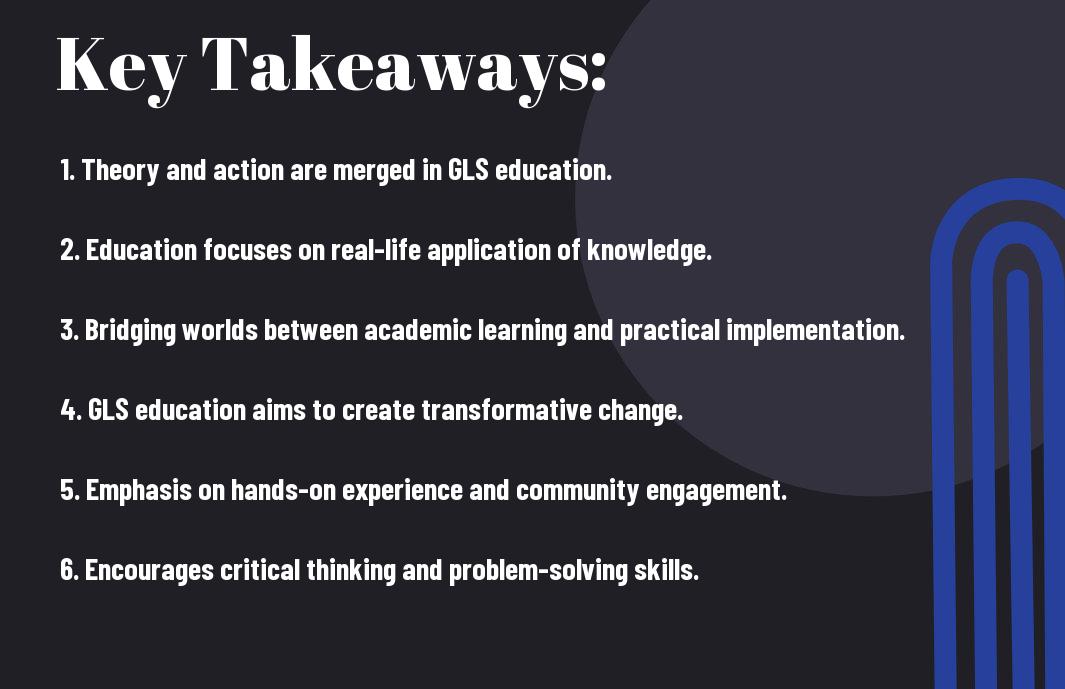Eudaimonia, a term often associated with Aristotle, represents a state of flourishing and well-being. In the realm of education, the pursuit of eudaimonia translates to the holistic development of students, encompassing not only academic knowledge but also social and emotional growth. GLS Education, with its innovative approach, aims to bridge the gap between theoretical knowledge and real-world application. By integrating experiential learning and community engagement, GLS Education empowers its students to become active agents of change, applying their learning to address real-world challenges. In this blog post, we will delve into how GLS Education effectively merges theory with transformative action, equipping students with the skills and mindset to make a meaningful impact in the world.
Key Takeaways:
- Integration of Theory and Action: GLS Education effectively combines theoretical knowledge with practical application, bridging the gap between academia and real-world impact.
- Transformative Education: The focus on transformative action emphasizes the importance of creating tangible change in individuals, communities, and society at large.
- Critical Thinking and Global Citizenship: GLS Education places a strong emphasis on cultivating critical thinking skills and promoting global citizenship, preparing students to think critically and take action on a global scale.


Theoretical Frameworks in GLS Education
If you are looking to understand the underpinnings of Global Learning Systems (GLS) Education, it is crucial to delve into the theoretical frameworks that guide its transformative action. These frameworks provide the foundation for the integration of theory and practice in the pursuit of holistic education and societal change.
Historical and Philosophical Foundations
With a rich history stemming from the works of influential philosophers and educators such as John Dewey, Maria Montessori, and Paulo Freire, GLS Education draws from a range of historical and philosophical foundations. These thinkers emphasized the importance of experiential learning, student-centered approaches, and the interconnectedness of education with social and political contexts. With a focus on critical pedagogy and the cultivation of agency and empowerment, GLS Education builds upon these historical foundations to shape its approach to transformative action.
Contemporary Educational Theories
Historical foundations laid the groundwork for GLS Education to embrace contemporary educational theories that continue to inform its practice. This includes constructivist theories, ecological perspectives, and the integration of technology and globalization in education. By incorporating these contemporary theories, GLS Education remains at the forefront of innovative and responsive pedagogical approaches, ensuring that its products are well-equipped to navigate the complexities of today’s interconnected world.
Transformative Practices in GLS Education
After laying the theoretical groundwork, GLS education moves into the realm of transformative action. This is where the rubber meets the road, and educators can see the tangible impact of their work on the lives of their students. In this chapter, we will explore some of the transformative practices that are being employed in GLS education, and examine how they are bridging the gap between theory and real-world application.
Case Studies of Applied Theory
One of the most compelling aspects of GLS education is the emphasis on real-world application of theoretical concepts. This can be seen in a number of case studies, where educators have applied GLS principles to their teaching methods with remarkable results. Some of these case studies include:
- Case Study 1: Implementing project-based learning in a low-income school district, resulting in a significant increase in student engagement and academic performance.
- Case Study 2: Utilizing community partnerships to enhance the learning experience for students, leading to a greater sense of social responsibility and civic engagement.
- Case Study 3: Introducing game-based learning techniques in a diverse classroom, resulting in improved problem-solving skills and collaboration among students.
Integrating Technology and Innovation
Studies have shown that integrating technology and innovation into the classroom can have a profound impact on student learning and engagement. In the realm of GLS education, this is particularly significant, as it allows educators to create immersive, interactive learning experiences that mirror the complexities of the real world. By incorporating technology and innovation into their teaching strategies, educators are equipping their students with the skills and mindset necessary to thrive in an ever-evolving global landscape.
Integrating technology and innovation in GLS education enables educators to create dynamic learning environments that cater to diverse learning styles and foster a culture of continuous improvement. By leveraging tools such as virtual reality simulations, artificial intelligence applications, and collaborative online platforms, educators can provide their students with a rich, multidimensional learning experience that goes beyond traditional classroom instruction. This approach empowers students to become active participants in their own education, shaping their own learning journeys and preparing them to navigate the complexities of the modern world.
Impact and Outcomes
Despite the challenges faced by GLS education programs, the impact and outcomes they have achieved cannot be overlooked. These programs have successfully merged theoretical knowledge with transformative action, resulting in tangible differences within communities and individuals.
Measuring Success in GLS Programs
To assess the success of GLS programs, it is imperative to measure their impact on various stakeholders. This includes evaluating the changes in attitudes, behaviors, and skills of the participants. Additionally, the quantitative data such as increased academic performance, higher graduation rates, and improved community engagement are crucial indicators of success.
Furthermore, the long-term economic and social impact on the communities where GLS programs are implemented is also a significant measure of success. By analyzing the lasting effects of these programs on local businesses, governments, and institutions, we can gauge their overall contribution to the sustainable development of the communities.
Long-Term Benefits for Communities
On a broader scale, the long-term benefits for communities resulting from GLS education programs are evident. These benefits include enhanced social cohesion, increased economic opportunities, and a more informed and engaged citizenry. The ripple effect of empowering individuals through education contributes to the overall development and advancement of communities.
Outcomes such as improved job prospects, more active participation in civic life, and reduced inequality are the byproducts of successful GLS programs. These outcomes not only benefit the individuals and communities directly involved in the programs, but also contribute to a more equitable and sustainable society as a whole.
Overcoming Challenges
For any GLS education initiative, there are a number of challenges to be navigated and overcome. These challenges can include practical constraints as well as the need for sustainable implementation strategies.
Navigating Practical Constraints
With limited resources, competing priorities, and varying levels of buy-in from stakeholders, navigating practical constraints can be a daunting task. It is important for GLS education practitioners to carefully assess the resources available to them and prioritize their use in a way that maximizes impact. This may involve creative problem-solving, collaboration with other departments or organizations, and a willingness to adapt to changing circumstances.
Strategies for Sustainable Implementation
Overcoming the challenges of sustainable implementation requires a long-term perspective and a commitment to ongoing evaluation and refinement. GLS education initiatives cannot thrive in a one-off, short-term approach. Rather, they require careful planning, consistent advocacy, and a dedication to building capacity within the organization. By leveraging support from key stakeholders, creating a culture of continuous improvement, and integrating GLS principles into existing systems and processes, sustainable implementation can become a reality.
Challenges such as resource limitations and stakeholder buy-in must be carefully considered and addressed in the development of sustainable implementation strategies. By proactively identifying potential obstacles and developing contingency plans, GLS education practitioners can mitigate the impact of these challenges and move towards successful, long-term integration of GLS principles into their educational institutions.
The Conclusion of Bridging Worlds – How GLS Education Merges Theory with Transformative Action
The work of Bridging Worlds – How GLS Education Merges Theory with Transformative Action highlights the importance of incorporating practical, real-world experiences into educational models. By bridging the gap between theory and action, GLS Education offers a unique approach that not only equips students with essential knowledge but also instills in them the ability to apply this knowledge in meaningful ways. This comprehensive approach to education has the potential to drive real change and empower individuals to become active contributors to a better society. As we continue to navigate an ever-changing world, it is crucial to embrace educational practices that emphasize both theoretical understanding and practical application, and GLS Education’s model provides an exemplary blueprint for achieving this balance.
FAQ
Q: What is “Bridging Worlds – How GLS Education Merges Theory with Transformative Action” about?
A: “Bridging Worlds” is a program that focuses on integrating theory and practice in Global Leadership and Sustainable Development education. It aims to prepare students to address complex global challenges by combining academic knowledge with hands-on experience in the field.
Q: What are the key components of the program?
A: The program includes a combination of rigorous academic coursework, experiential learning opportunities, and a capstone project that allows students to apply their learning in a real-world context. It also emphasizes the development of critical thinking, problem-solving, and leadership skills necessary for addressing global issues.
Q: What makes “Bridging Worlds” unique compared to other educational programs?
A: “Bridging Worlds” stands out for its emphasis on merging theory with action. It provides students with the opportunity to engage with diverse communities and stakeholders, gain practical skills through fieldwork, and develop a deep understanding of the interconnectedness of global issues. This holistic approach equips students to become effective and responsible leaders in the field of sustainable development.
